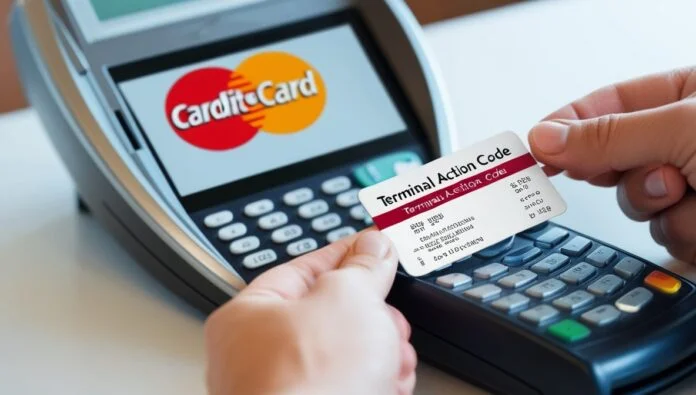Terminal Action Code: What It Means and How It Works
Terminal action code is an important term you might hear in banking, finance, and credit card processing. Terminal action code tells the bank or payment system what to do when a transaction is made. For example, it can decide if a payment should be approved, declined, or if extra verification is needed. Every payment terminal uses terminal action codes to communicate with the bank. This code helps keep transactions safe and smooth. Without terminal action codes, banks might not know how to handle payments, which could cause delays or errors. Understanding terminal action codes can make it easier for business owners and customers to handle card payments safely. It also helps explain why some transactions fail even when the card is correct. Learning about these codes is very useful if you want to understand the world of payments better.
Terminal action code is also used to control specific rules for transactions. Banks can set terminal action codes for different situations, like high-value payments or transactions from certain countries. These codes can tell the terminal to ask for a PIN, require approval from the bank, or block a transaction if it seems suspicious. This helps reduce fraud and protect both customers and businesses. Every card network, like Visa or Mastercard, has its own set of terminal action codes, but they all work in a similar way. For shop owners, knowing terminal action codes can help solve issues when a transaction is declined. For customers, it can explain why a card might be rejected even when it has enough balance. Terminal action codes make card payments safer, faster, and more reliable, which is why they are a key part of modern banking.
Terminal Action Code: A Simple Guide for Beginners
Terminal action code is a special code used in card payments to tell the bank what to do with a transaction. Every time you swipe, tap, or insert your card, the terminal sends information to the bank, and the terminal action code helps the bank decide if it should approve or decline the payment. These codes make payments safer and faster because they give clear instructions for handling each transaction. Beginners can think of terminal action codes as traffic signals for payments – they guide the transaction and keep it smooth. Knowing about them helps you understand why some payments go through easily while others may be stopped or need extra verification.
How Terminal Action Codes Keep Your Payments Safe
Terminal action codes play a big role in keeping card payments safe. They tell the payment system how to react to different situations, such as suspicious transactions or high-value purchases. When a terminal action code detects something unusual, it may ask for a PIN, require bank approval, or block the transaction to prevent fraud. Banks and card networks use these codes to protect both customers and merchants from losing money. Without terminal action codes, it would be hard to control risks in digital payments. Learning how these codes work can give you confidence when using cards and help you understand why some transactions need extra checks before being approved.
Understanding Terminal Action Codes Step by Step
Terminal action codes can seem complicated, but they are easy to understand when broken into steps. First, the card terminal reads the card information. Then, it sends the payment request to the bank, including the terminal action code. The bank checks the code and decides what to do next. The code might approve the transaction, ask for more verification, or decline it. Each code has a specific meaning, so terminals and banks know exactly how to act. Step-by-step understanding helps merchants and customers know why a transaction behaves a certain way. With a little practice, terminal action codes become simple tools that make payments safer and more reliable.
Types of Terminal Action Codes and Their Uses
There are several types of terminal action codes, and each has a unique job. Some codes tell the terminal to approve payments automatically, while others require bank approval or a PIN check. Some codes are set to block suspicious or risky transactions to prevent fraud. Merchants can also use these codes to set rules for different types of payments, like online orders or international purchases. Understanding these types helps both businesses and customers handle card payments better. By knowing the codes, you can predict why a transaction might be stopped or why extra verification is needed. Terminal action codes are like little guides that keep every payment safe and smooth.
Terminal Action Code: Why Your Transaction Got Declined
Sometimes, your card transaction gets declined even when your balance is enough. Terminal action codes are often the reason. The code might tell the bank to block a payment if it seems unusual, is over a set limit, or comes from a different country. Other times, the code asks for extra verification, like entering a PIN, to make sure the payment is safe. Understanding terminal action codes helps you know why a decline happens and how to fix it. Merchants and customers benefit from this knowledge because it explains unexpected payment behavior and reduces frustration during card payments, keeping transactions secure for everyone involved.
How Banks Use Terminal Action Codes to Approve Payments
Banks rely on terminal action codes to decide quickly whether to approve a payment. When a customer swipes their card, the terminal sends a request with the code. The bank looks at the code and checks for risks, such as unusual spending patterns or high-value purchases. If everything is normal, the bank approves the payment. If not, the bank might request extra verification or block the transaction. Terminal action codes make this process automatic, saving time for both the bank and the customer. By controlling approval rules, banks can prevent fraud and errors, ensuring smooth transactions and protecting cardholders from losing money during daily purchases.
Terminal Action Codes and Fraud Protection Made Easy
Terminal action codes are very important for fraud protection. They help banks and card networks spot suspicious transactions quickly. If a payment looks unusual, the terminal action code can trigger extra checks, ask for a PIN, or decline the transaction. This prevents stolen cards or fake payments from causing losses. Merchants also benefit because they can reduce chargebacks and protect their business. Learning about terminal action codes helps customers understand why some payments need verification and why some might fail. These codes work quietly behind the scenes, keeping your money and personal information safe while making card payments secure and reliable every day.
Troubleshooting Payment Problems with Terminal Action Codes
When a card payment fails, terminal action codes are often the reason. Troubleshooting starts by understanding what the code means. Some codes require a PIN, some need bank approval, and some block unusual transactions. By checking the terminal action code, merchants can know why a transaction was declined. Customers can also use this information to fix problems, like calling the bank or entering the correct PIN. Troubleshooting with terminal action codes saves time and avoids confusion during payments. These codes make it clear what needs to happen for a transaction to succeed, helping both businesses and customers enjoy smooth, safe card payment experiences.
Terminal Action Codes in Different Card Networks
Different card networks like Visa, Mastercard, and American Express use terminal action codes in slightly different ways. Each network has its own set of rules for approving, declining, or verifying payments. Despite these differences, the main purpose is the same: to keep transactions safe and smooth. Merchants who accept multiple card types benefit by understanding how each network uses codes. Customers also get insights into why a card might work on one network but not another. Terminal action codes provide a universal system for handling transactions, while network-specific rules ensure that payments follow local and international standards. This makes card payments reliable everywhere.
Conclusion
Terminal action codes are very important for every card payment. They help banks and terminals know what to do with each transaction. These codes can approve payments, ask for a PIN, or stop a suspicious transaction. Knowing about them makes it easier for customers and merchants to understand why payments sometimes fail. They keep transactions safe, fast, and smooth.
Learning about terminal action codes also helps you solve payment problems quickly. If a card gets declined, understanding the code can tell you what went wrong. Businesses can use these codes to protect themselves from fraud. Overall, terminal action codes make card payments simple and safe for everyone.
FAQs
Q: What is a terminal action code?
A: It is a code used by banks and card terminals to decide if a payment should be approved, declined, or verified.
Q: Why do transactions get declined because of terminal action codes?
A: Some codes block payments if they seem suspicious, are high-value, or need extra verification to keep money safe.
Q: Can merchants use terminal action codes to protect their business?
A: Yes, merchants can set rules using these codes to prevent fraud and make sure payments are safe and smooth.






